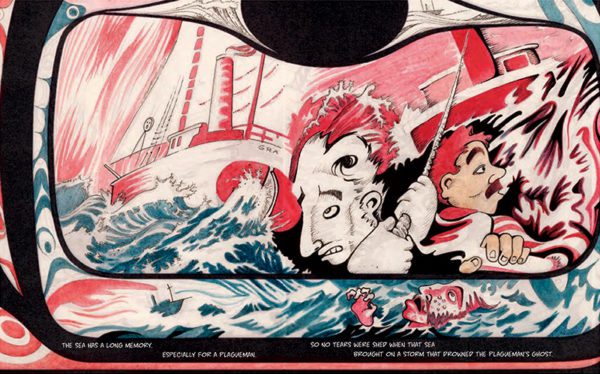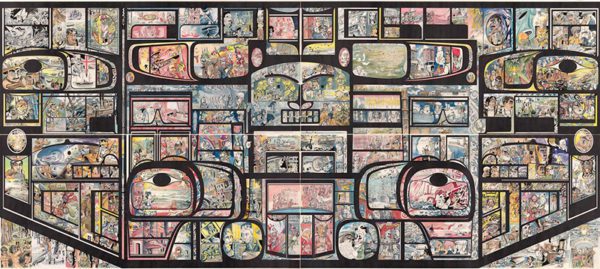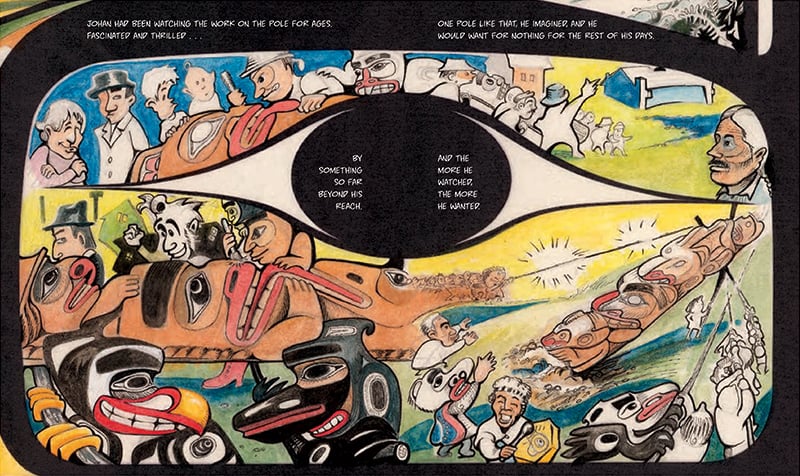What is a “Haida manga”? It’s been a decade and a half since Michael Nicoll Yahgulanaas published the first book bearing this evocative epithet, and the landscape of graphic novels has continued to evolve. The cartoonist’s fourth foray into this unique graphic format, JAJ: A Haida Manga (Douglas & McIntyre), published for Indigenous History Month, explores early contact between Haida and Europeans.
JAJ takes its title from the initials of one of its central characters – a poor, Norwegian-born fisher-turned-adventurer by the name of Johan Adrian Jacobsen. Yahgulanaas’s first Haida manga, RED (2009), and its follow-ups War of the Blink (2017) and Carpe Fin (2019), were set firmly in Haida Gwaii and the nearby mainland, and took a cosmological perspective, not restricted to linear history. In this new, true story of contact between continents and cultures, Yahgulanaas again casts a wide net, bringing to life late 19th-century Berlin, old New York, and colonial Canada to depict a wave of clashes and conflicts that crashed upon the shores of the new province of British Columbia, including Yahgulanaas’s own village of Massett, where Jacobsen once visited.
With this pivot to historical cartooning, Yahgulanaas acknowledges a team of more than 10 researchers who contributed to the project, uncovering many of the details that bring JAJ to life. But he sees a continuity between this work of “hard” history and his earlier works.
“The time scale doesn’t diminish the reality that human characteristics are consistent across many, or perhaps even all, generations. Looking at these historical characters, and recognizing my commonality allowed for a deeper sympathy, and perhaps understanding of the circumstances they found themselves in,” Yahgulanaas says. “This is why it was so important in the book to establish the context and upheaval that was characteristic of northern Europe in the 1880s. This is why I had to refer to the violent birth of America and Canada. I also had to look at my own great-great-grandparents and community and see how they might have received Johan’s appearance.” Though JAJ brings to the fore many of the atrocities committed against Yahgulanaas’s Haida forebears by European settlers, the research simultaneously helped him to humanize his narrative: “I discovered a [personal] Norwegian family link and this profoundly impacted … how I viewed JAJ and his similar early years in a fishing family on an isolated island in the North Atlantic. That sympathy allowed me to step farther away from tropes.”
Jacobsen arrived in Berlin from his small coastal village, looking to make his fortune. At the time, the Ethnological Museum of Berlin was looking to build a collection of global artifacts to rival those of other European capitals. Jacobsen was dispatched to raid the treasures of the Haida Gwaii for the museum, and at the top of his “shopping list” was a totem pole. In JAJ, Yahgulanaas illuminates the many contexts of Jacobsen’s cross-continent trek: the execution of the Lakota ordered by Abraham Lincoln, the labour issues that culminated in the Haymarket massacre in Chicago, the smallpox-bearing plaguemen of British Columbia. These details swirl and coalesce into a narrative that is idiosyncratic and specific, and yet touches every part of the world we live in today.

In fact, a panoply of details that converge into a grander, universal narrative characterizes all of Haida manga. Yahgulanaas paints each one as a large-scale mural, fusing traditional Haida motifs with contemporary cartooning. Each mural is then broken into roughly 100 sections, to become the pages of each graphic novel. The lithe, full-colour action is depicted not in the conventional boxes and rectangular panels of comics, but among the curves and undulations of traditional Haida formline drawings, rendered in supple brushwork, that constitute the framework of the mural. While each page individually only reveals a small piece of this larger work, the image of the mural as a whole is found in the backmatter of JAJ.
Most readers will not see the larger mural image at its original size. JAJ, the mural, was a commission from the Humboldt Forum in Berlin, the successor institution to the museum that sent Jacobsen to Haida Gwaii in the 1880s. Visitors can view the eight-square-metre, watercolour-and-ink mural as well as the totem pole Jacobsen obtained. But for Yahgulanaas, the mural doesn’t give this important story the reach it deserves; he explains that “by creating publications, I am wanting to take these large and complex artworks and make them immediately accessible to a broader audience, as the idea of Haida manga is to try to perforate unhealthy barriers [to access].”

JAJ, Humboldt Forum, Berlin (Michael Nicoll Yahgulanaas)
“Haida manga retains enough visual clues that even an uninformed reader is able to appreciate that the work is an Indigenous voice.” The formline tradition shapes – literally outlines – the narrative. This variety of scales is central to what Yahgulanaas calls his “ongoing studio challenge,” which feels like “creating a visual scene using a microscope, binoculars, and a telescope” all at once.
“I look at large artworks, including architecture, and appreciate how awesome they can be…. As one approaches [a Haida manga] mural from a distance, we perceive shape and colours that come into focus the closer we come up to the surface. Our initial assumptions about what it is we are viewing change according to the degree of detail that is presented to us. That which is confusing at the larger scale becomes clear, intimate, and subject to the sovereignty of the reader who holds the same imagery in a book.” Yahgulanaas’s approach to history – a history of cultures and continents seen through the lives of individuals – is mirrored in this unique aesthetic form that he has created.
“Historical traditions are in a constant state of evolution. I am an advocate of the tradition of innovation,” offers Yahgulanaas, on his unique mix of traditional art practices and relatively modern formats, such as the graphic novel. “Haida manga is very consistent with artistic expression that is constantly looking for opportunities to improve its relevance to its audience.”
Haida manga, then, is the result of this method of bold graphic storytelling, in the service of complex narratives, at multiple scales. “The design theories used in monumental totem poles,” quips Yahgulanaas, “are equally applied to one’s wedding band.”

 Contact us via email
Contact us via email

